
95% of researchers rate our articles as excellent or good
Learn more about the work of our research integrity team to safeguard the quality of each article we publish.
Find out more
ORIGINAL RESEARCH article
Front. Earth Sci. , 21 October 2021
Sec. Volcanology
Volume 9 - 2021 | https://doi.org/10.3389/feart.2021.713175
This article is part of the Research Topic High-Performance Computing in Solid Earth Geohazards: Progresses, Achievements and Challenges for a Safer World View all 10 articles
Parts of this article's content have been modified or rectified in:
Erratum: Modelling Settling-Driven Gravitational Instabilities at the Base of Volcanic Clouds Using the Lattice Boltzmann Method
Field observations and laboratory experiments have shown that ash sedimentation can be significantly affected by collective settling mechanisms that promote premature ash deposition, with important implications for dispersal and associated impacts. Among these mechanisms, settling-driven gravitational instabilities result from the formation of a gravitationally-unstable particle boundary layer (PBL) that grows between volcanic ash clouds and the underlying atmosphere. The PBL destabilises once it reaches a critical thickness characterised by a dimensionless Grashof number, triggering the formation of rapid, downward-moving ash fingers that remain poorly characterised. We simulate this process by coupling a Lattice Boltzmann model, which solves the Navier-Stokes equations for the fluid phase, with a Weighted Essentially Non Oscillatory (WENO) finite difference scheme which solves the advection-diffusion-settling equation describing particle transport. Since the physical problem is advection dominated, the use of the WENO scheme reduces numerical diffusivity and ensures accurate tracking of the temporal evolution of the interface between the layers. We have validated the new model by showing that the simulated early-time growth rate of the instability is in very good agreement with that predicted by linear stability analysis, whilst the modelled late-stage behaviour also successfully reproduces quantitative results from published laboratory experiments. The results show that the model is capable of reproducing both the growth of the unstable PBL and the non-linear dependence of the fingers’ vertical velocity on both the initial particle concentration and the particle diameter. Our validated model is used to expand the parameter space explored experimentally and provides key insights into field studies. Our simulations reveal that the critical Grashof number for the instability is about ten times larger than expected by analogy with thermal convection. Moreover, as in the experiments, we found that instabilities do not develop above a given particle threshold. Finally, we quantify the evolution of the mass of particles deposited at the base of the numerical domain and demonstrate that the accumulation rate increases with time, while it is expected to be constant if particles settle individually. This suggests that real-time measurements of sedimentation rate from volcanic clouds may be able to distinguish finger sedimentation from individual particle settling.
Explosive volcanic eruptions can inject large quantities of ash into the atmosphere, generating multiple hazards at various spatial and temporal scales (Blong, 2000; Bonadonna et al., 2021). Subsequent volcanic ash dispersal and sedimentation can strongly disrupt air traffic (Guffanti et al., 2008; Prata and Rose, 2015), affect inhabited areas (Spence et al., 2005; Jenkins et al., 2015), and impact ecosystems and public health (Gudmundsson, 2011; Wilson et al., 2011). A good understanding of ash dispersal is critical for effective forecasting and management of the response to these hazards. Modern volcanic ash transport and dispersal models have now reached high levels of sophistication (Jones et al., 2007; Bonadonna et al., 2012; Folch, 2012; Folch et al., 2020; Prata et al., 2021) but do not include all of the physical processes affecting ash transport, such as particle aggregation and settling-driven gravitational instabilities (e.g., Durant, 2015). Various studies have highlighted the need to take these processes into account by revealing discrepancies between field measurements and numerical models (Scollo et al., 2008), premature sedimentation of fine ash leading to bimodal grainsize distributions not only related to particle aggregation (Bonadonna et al., 2011; Manzella et al., 2015; Watt et al., 2015) and significant depletion of airborne fine ash close to the source (Gouhier et al., 2019).
Alongside particle aggregation, settling-driven gravitational instabilities contribute to the early deposition of fine ash with similar outcomes (e.g., grainsize bimodality, premature sedimentation of fine ash). These instabilities generate downward-moving ash columns (fingers) which grow from the base of the ash cloud (Figure 1) (Carazzo and Jellinek, 2012; Manzella et al., 2015; Scollo et al., 2017). This phenomenon has the potential to enhance the sedimentation rate of fine ash beyond the terminal fall velocity of individual particles, reducing the residence time of fine ash in the atmosphere. Thus, a rigorous understanding of these processes is important in order to build a comprehensive parametrisation that can be included in dispersal models (Scollo et al., 2010; Bonadonna et al., 2012; Folch, 2012; Durant, 2015).

FIGURE 1. Gravitational instabilities observed at the base of a volcanic plume during (A) the 2011 Gamalama eruption (Indonesia) (Credit: AP) and (B) the 2010 eruption of Eyjafjallajökull (Iceland) (Manzella et al., 2015).
Settling-driven gravitational instabilities should be fully characterized as they also have the potential to impact other ash-related processes. First, the high particle concentration and the turbulence induced by fingers (i.e., the intrinsic turbulence within fingers as well as the shear generated during the downward motion) may enhance particle aggregation by increasing the collision rate of particles (Costa et al., 2010; Scollo et al., 2017). This process could happen regardless of plume height and atmospheric conditions contrary to ice-nucleation for example, which requires specific conditions (Maters et al., 2020). Second, as settling-driven gravitational instabilities trigger premature deposition of fine ash, this may affect the residence time of other elements in the plume. Indeed, fine ash is involved in some geochemical processes such as the adsorption of volatiles (e.g., sulphur or halogens) (Bagnato et al., 2013; Zhu et al., 2020). Considering that the sedimentation rate of volatiles depends on the sedimentation rate of fine ash, the possible premature deposition of volatiles can be explained by the presence of both settling-driven gravitational instabilities and particle aggregation. Finally, fine ash has been shown to play an important role in the volcanic cloud heating through radiative processes that may affect the dynamics (Niemeier et al., 2009; Stenchikov et al., 2021). Thus, in order to model the large-scale transport of volcanic clouds, there is a need to estimate accurately the amount of fine ash within the cloud, and, therefore, to constrain all size-selective sedimentation processes such as settling-driven gravitational instabilities.
Settling-driven gravitational instabilities occur at the interface between an upper, buoyant particle suspension, e.g., a volcanic ash cloud, and a lower, denser fluid, e.g., the underlying atmosphere (Hoyal et al., 1999; Burns and Meiburg, 2012; Manzella et al., 2015; Davarpanah Jazi and Wells, 2016). Whilst the initial density configuration is stable, particle settling across the density interface creates a narrow unstable region called the particle boundary layer (PBL) (Carazzo and Jellinek, 2012). Once this attains a critical thickness (Hoyal et al., 1999), a Rayleigh-Taylor-like instability (Chandrasekhar, 1961; Sharp, 1984) can form on the interface between the PBL and the lower layer, generating finger-like structures which propagate downwards. A further critical condition for instability is that the particle settling velocity
Settling-driven gravitational instabilities have been widely studied in laboratory experiments that simulate various natural settings. Many experiments have considered an initial two-layer system, where the particle suspension is initially separated from the underlying denser layer by a removable horizontal barrier (Hoyal et al., 1999; Harada et al., 2013; Manzella et al., 2015; Davarpanah Jazi and Wells, 2016; Scollo et al., 2017; Fries et al., 2021) whilst other experiments have involved injection of the suspension into a density-stratified fluid at its neutral buoyancy level (Cardoso and Zarrebini, 2001; Carazzo and Jellinek, 2012). Similar instabilities can also be studied by allowing fine particles to sediment through the free surface between water and air (Carey, 1997; Manville and Wilson, 2004). Additionally, dimensional analysis has been used to predict that the downward propagation velocity of the generated fingers is given by (Hoyal et al., 1999; Carazzo and Jellinek, 2012)
where
where
For the initial two-layer configuration, Hoyal et al. (1999) also developed a series of analytical mass-balance models predicting the average particle concentration in the lower layer depending on whether the upper and lower layers were convecting or not. In the case of a quiescent upper layer and a convective lower layer (convection initiated by finger propagation), the evolution of the mass of particles in the lower layer
where
where
Further studies of settling-driven gravitational instabilities have taken theoretical approaches, such as using linear stability analyses to predict the growth rate and characteristic wavelengths of the instability at very early stages (Burns and Meiburg, 2012; Yu et al., 2013; Alsinan et al., 2017). Moreover, various numerical models simulating settling-driven gravitational instability have also been developed (Jacobs et al., 2013; Burns and Meiburg, 2014; Yamamoto et al., 2015; Chou and Shao, 2016; Keck et al., 2021). Most numerical approaches to this problem have used continuum-phase models, where the coupling between particles and fluid is strong enough to describe them as a single-phase (Burns and Meiburg, 2014; Yu et al., 2014; Chou and Shao, 2016). This Eulerian description is valid under the assumptions of sufficiently small particles and a large enough number of particles such that the drag and gravitational forces are in equilibrium. The condition on the particle size can be quantified through the Stokes number (Burgisser et al., 2005; Roche and Carazzo, 2019), one possible definition of which is
where
The Eulerian description can be extended to multiple phases in order to simulate their interaction (e.g., gas-liquid interaction) using adaptive mesh refinements to resolve the phase interfaces (Jacobs et al., 2013). However, for large particle diameters and small particle volume fractions, collective behaviour no longer occurs and the continuum-phase method cannot be applied. In this case, there is a need to explicitly model particle motion, taking the drag force into consideration (Yamamoto et al., 2015; Chou and Shao, 2016).
This paper presents an innovative method to implement a continuum model by coupling the Lattice Boltzmann Method (LBM) with a low-diffusivity finite difference (FD) scheme. This model takes advantage of the LBM capabilities to simulate complex flows through uniform grids and thus, the ease of coupling with finite difference methods. This hybrid model has been validated by comparing the results with those from linear stability analysis and laboratory experiments (Fries et al., 2021). The validated model then allows us to gain new insights into the fundamental processes by exploring experimentally-inaccessible regions of the parameter space. We first describe the general framework and governing equations that describe settling-driven gravitational instabilities, then the configuration of the validatory experiments to which we apply the model. Next, we propose a numerical strategy involving a hybrid model in order to solve the system of equations. We then go on to present the linear stability analysis before finally describing and discussing the results of our simulations.
The model consists of a three-way coupling between fluid momentum, fluid density, and particle volume fraction, based on the assumption that the particle suspension can be represented by a continuum concentration field. Moreover, the particle drag force is in equilibrium with the gravitational force such that the forcing term in the fluid momentum equation is equivalent to a buoyant force term (Boussinesq approximation), which depends on the particle volume fraction
where
The particle settling velocity depends on the ambient fluid density
where
where
The system of equations presented so far assumes that all particles are of uniform size. In order to generalise to systems with polydisperse particle size distributions, we consider
where
Full details of the validatory laboratory experiments can be found in Fries et al. (2021) but we summarise the essential details here. The experiments are performed in a configuration identical to that of Manzella et al. (2015) and Scollo et al. (2017) (Figure 2) and consist of a water tank divided into two horizontal layers, initially separated by a removable barrier. The upper layer is an initially mixed particle suspension, which represents the ash cloud, and the lower layer is a dense sugar solution, analogue to the underlying atmosphere. The particles are spherical glass beads with a median diameter of
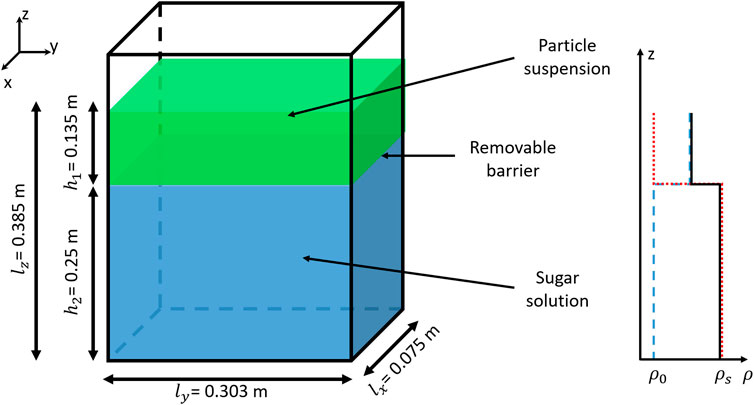
FIGURE 2. Experimental setup used by (Fries et al., 2021) and the initial density profiles associated with the contributions from particles (blue dashed) and sugar (red dotted), as well as the bulk density (black solid). The density of fresh water is given by
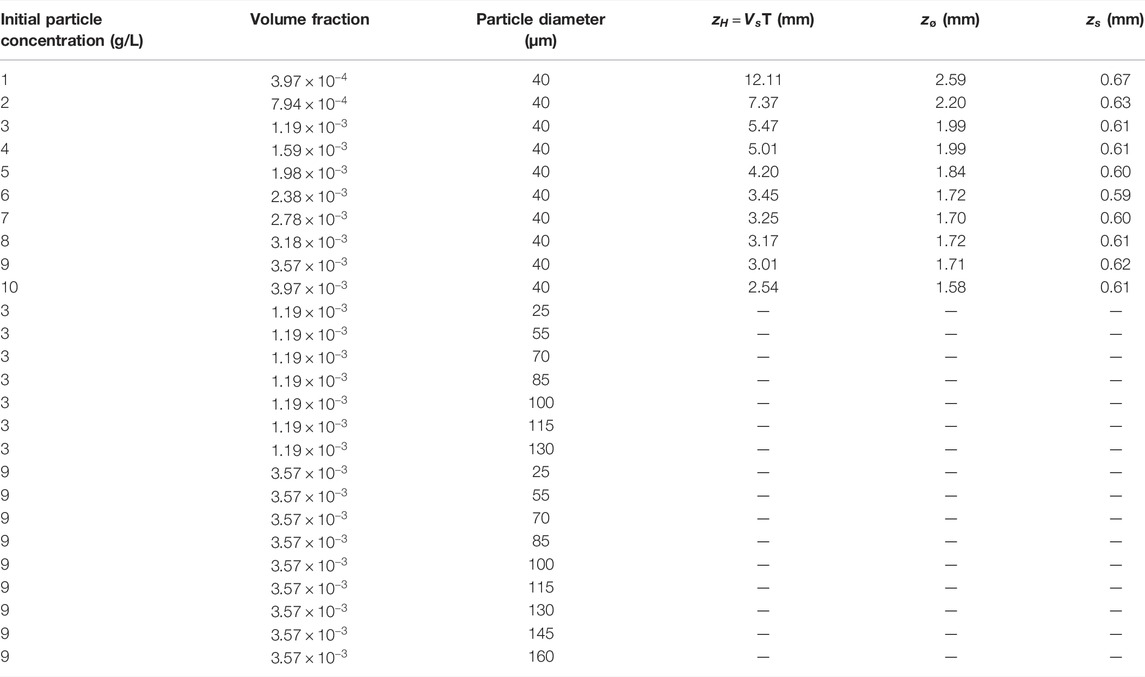
TABLE 1. List of simulations performed. All the simulations have been performed using an initial lower layer fluid density of 1008.4 kg/m3.
Before starting an experiment, the upper layer is manually and carefully stirred using a brush. Then the barrier separating the two layers is immediately removed, allowing particle settling through the interface. A PBL subsequently forms and finger formation is initiated. Experiments are illuminated from the side of the water tank with a planar laser and recorded with a high-contrast camera. We measure the vertical finger velocity by tracking the progression of the finger front with time. Additionally, Planar Laser Induced Fluorescence (PLIF) (Koochesfahani, 1984; Crimaldi, 2008) and particle imaging are used to quantify the spatial distribution of the fluid phase density and particle concentration.
We apply the general system of equations presented in Problem Formulation section to the configuration of the validatory experiments. The particles are spherical and sufficiently small that their terminal settling velocity in water is given by the Stokes velocity (Stokes, 1851)
where
The diluted system ensures the Boussinesq assumption is valid as the ratio
We simulate the solid walls of the tank around our domain with a no-slip boundary condition for the fluid velocity. Neumann boundary conditions are employed for
and
on the wall nodes. Furthermore, we define the following initial states for
and
where
The 3D numerical model is implemented using a hybrid strategy where a LBM solves the fluid motion and is coupled with finite difference schemes that solve the advection-diffusion equations for
The LBM is an efficient alternative to conventional Computational Fluid Dynamics (CFD) methods that explicitly solve the Navier-Stokes equations at each node of a discretised domain (He and Luo, 1997; Succi et al., 2010). It is a well-established approach for simulating complex flows, including multiphase fluids (Leclaire et al., 2017) and thermal and buoyancy effects (Parmigiani et al., 2009; Noriega et al., 2013). The LBM originates from the kinetic theory of gases and provides a description of gas dynamics at the mesoscopic scale. This scale exists between the microscopic, which describes molecular dynamics, and the macroscopic, which gives a continuum description of the system with variables such as density and velocity. Thereby, the mesoscopic scale considers a probability distribution function of molecules described by the Lattice Boltzmann equation. This model reduces the process to two main steps: streaming (i.e., displacement of populations between consecutive calculation nodes), and collision (i.e., interaction of populations on a node). The Bhatnagar-Gross-Krook (BGK) model (Bhatnagar et al., 1954) provides a simple collision process based on a fundamental property given by kinetic theory which describes gas motion as a perturbation around the equilibrium state. Then, the LBM-BGK model solves the equation
where the particle population
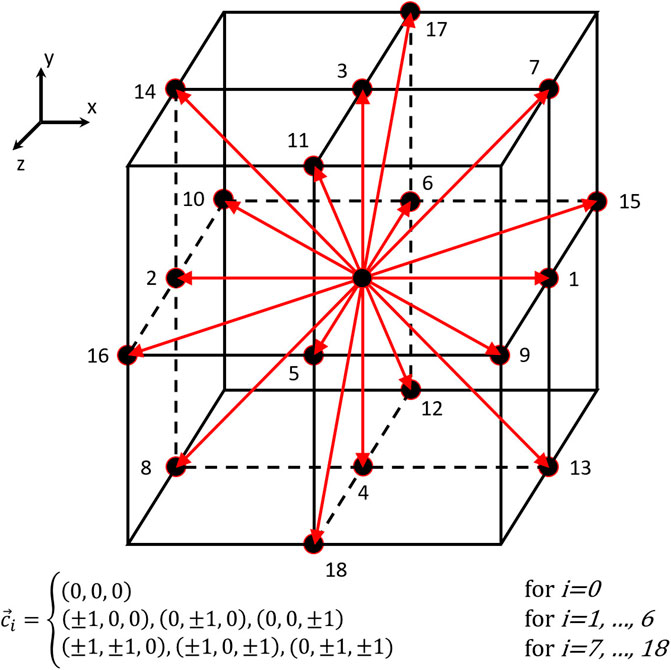
FIGURE 3. Depiction of the D3Q19 lattice. The red arrows show the different possible directions of propagation. The associated local velocities are summarised in the velocity set
The macroscopic fluid state is described through the usual macroscopic variables such as density, velocity and kinematic viscosity. These variables are related to the moments of the populations
and
whilst the kinematic viscosity controls the relaxation to equilibrium through the relaxation time
The variable
where
The particles and other density-altering quantities are described by continuum fields that follow an advection-diffusion law coupled with the fluid motion as simulated with the LBM. The numerical solution of the advection equation is particularly challenging for methods which, like ours, are Eulerian (i.e., mesh-based). Indeed, such methods exhibit numerical diffusion which may strongly reduce model accuracy and, in some cases, even exceed the amplitude of the actual, physical diffusion term. The lack of physical diffusion in our problem and the presence of sharp interfaces restrict our ability to solve the advection equations with the LBM. In fact, the advection-diffusion equation can be solved by the LBM with a BGK approach in analogous fashion to the fluid motion by modifying the equilibrium distribution and the relaxation time to depend on the diffusion coefficient
However, a stability condition for a LBM-BGK algorithm is
Coupling the LBM with an upwind finite difference scheme allows us to avoid the stability problem. First-order FD schemes however, still suffer from the problem of numerical diffusion due to the truncation error associated with terminating the Taylor expansion after the first spatial derivative. The induced numerical error
where
Further information on how we discretise the convective term in the advection-diffusion equation using the first order upwind and the third order WENO finite difference schemes is detailed in Section 1 of the Supplementary Figure S1.
Our model is implemented using Palabos (Parallel Lattice Boltzmann Solver), a Computational Fluid Dynamics (CFD) solver based on the Lattice Boltzmann Method and developed by the Scientific Parallel Computing group of the Computer Science Department, University of Geneva (Latt et al., 2020). Palabos is designed to perform calculations on massively parallel computers, thus allowing very small spatial resolutions for accurate simulation of the finger dynamics.
In order to validate our model, we compare the early-time simulated behaviour against predictions from linear stability analysis (LSA). LSA is applied to the onset of the physical instability at the interface between layers of different particle concentration. It involves defining a field equation-satisfying base state for each of the unknown fields in a problem and then applying an infinitesimally small perturbation to each of these fields. The equations are then expanded to linear order in the perturbation, with higher order terms assumed to be negligible. By assigning the perturbation to have the form of a complex waveform, the system of equations reduces to an eigenvalue problem, which can be solved to determine which wavelengths will grow or decay (Chandrasekhar, 1961). In this section, we assume that the system is invariant under translation in the
We nondimensionalise our system of equations by defining
and
where
and
noting that
and
Note that here we have neglected the term
We linearise the system of equations by expanding each variable in terms of a base state and a perturbation
where
and
where
Solutions for the perturbation are assumed to have the form of normal modes
where
and, in a reference frame moving downward at
and
where
The eigenvalues
• If all the eigenvalues have negative real parts, the system remains stable
• If at least one eigenvalue has a positive real part, the system is unstable.
In order to solve the eigenvalue problem, the spatial derivatives are discretised using the linear rational collocation method with a grid transformation allowing a fine resolution around narrow interfacial regions (Baltensperger and Berrut, 2001; Berrut and Mittelmann, 2004).
The key result of the LSA is the dispersion relation between
We validate our numerical model by comparing the results with predictions from LSA and experimental observations. The LSA predicts the growth rates of different perturbation wavenumbers during the very early stage of the instability, which can be compared with the spectrum of wavenumbers present in the particle concentration interface in the numerical model. Additionally, the experiments of Fries et al. (2021) employ imaging techniques to measure quantities, such as the particle concentration field and finger velocity, at times beyond the linear regime. Finally, our results are compared with some results of previous analyses on settling-driven gravitational instabilities (Hoyal et al., 1999; Carazzo and Jellinek, 2012).
In order to compare our 3D simulations with the 2D linear stability analysis, we consider just the central plane of the simulation domain, i.e., a slice in the
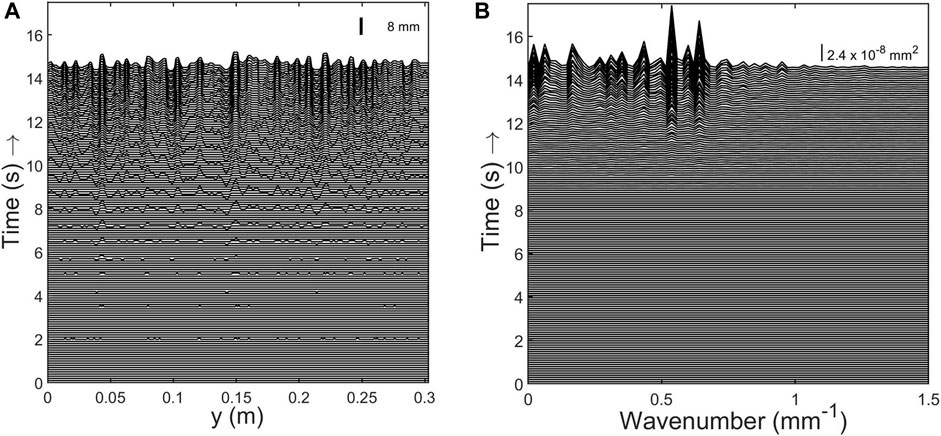
FIGURE 5. (A) Space-time diagram of the particle front height
During the linear regime, we can assume that the growth of the spectral amplitude can be described as (Völtz et al., 2001)
with
where
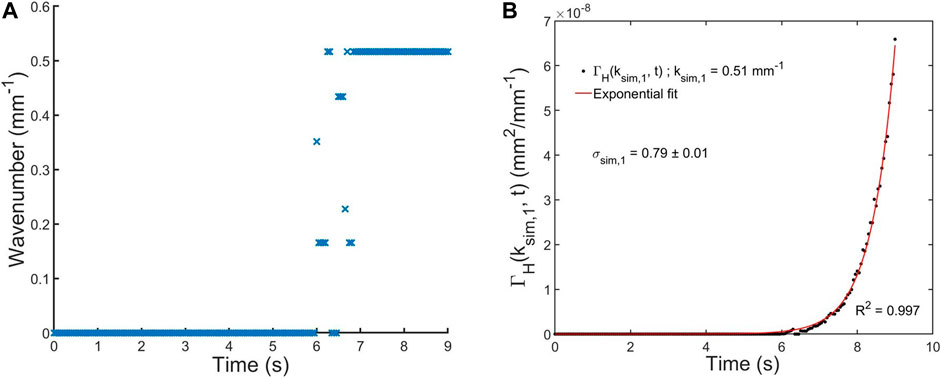
FIGURE 6. (A) Example of dominant wavenumbers extracted from the maximum of the PSD. Initial particle volume fraction
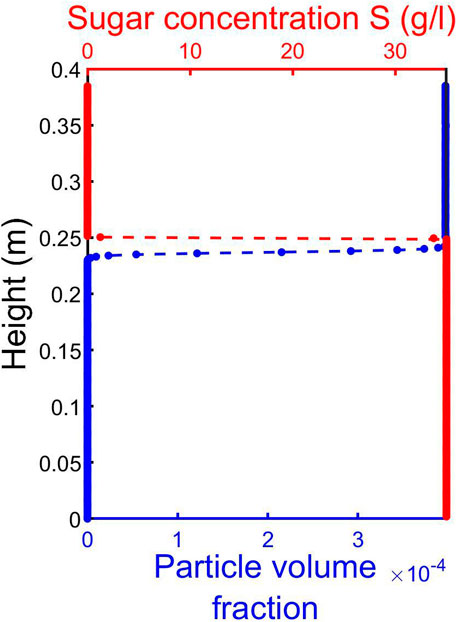
FIGURE 7. Example of LSA base states extracted from the simulations for
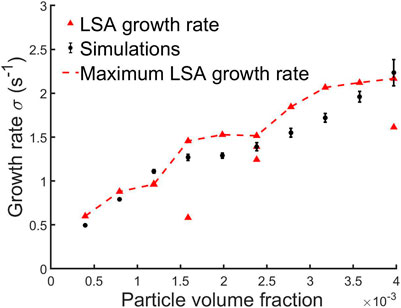
FIGURE 8. Comparison of the instability growth rate measured in the simulations (black circles) and that predicted by the linear stability analysis (red triangles).
Figures 9A,B show a qualitative comparison between snapshots taken from experiments (Fries et al., 2021) and simulations (slice in the numerical domain). First, we note that our model is able to qualitatively reproduce the shape and size of fingers, especially their fronts where we observe the formation of lobes and eddies due to the Kelvin-Helmholtz instability (Chou and Shao, 2016). Second, we provide a quantitative validation of the non-linear regime by comparing our model with experiments, through measurements of the PBL thickness and the vertical finger velocity as functions of the particle volume fraction and size.
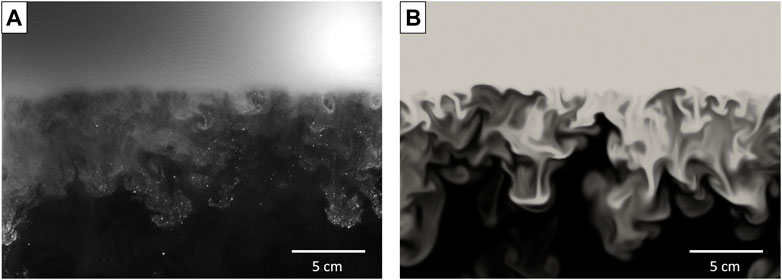
FIGURE 9. Settling-driven gravitational instabilities observed 19.5 s after the barrier removal (A) in the laboratory (Fries et al., 2021) and (B) in numerical simulations. Particle size: 40 µm and initial volume fraction:
The bulk density profile
Figure 10 shows the profiles of
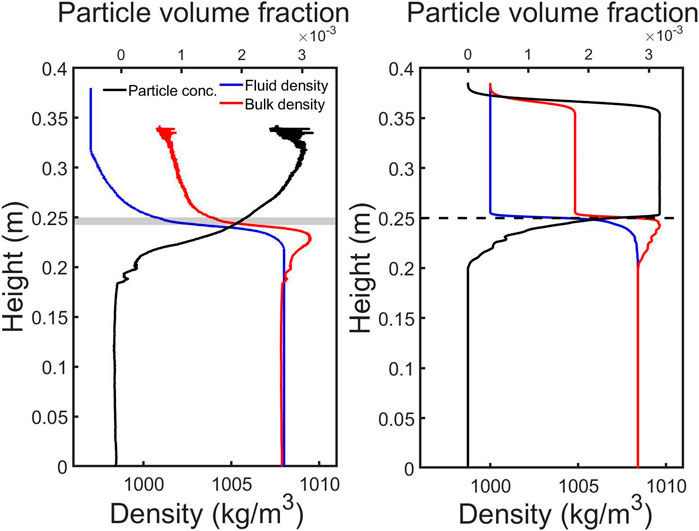
FIGURE 10. Density profile after 8 s for experiments (left) (Fries et al., 2021) and simulations (right) with
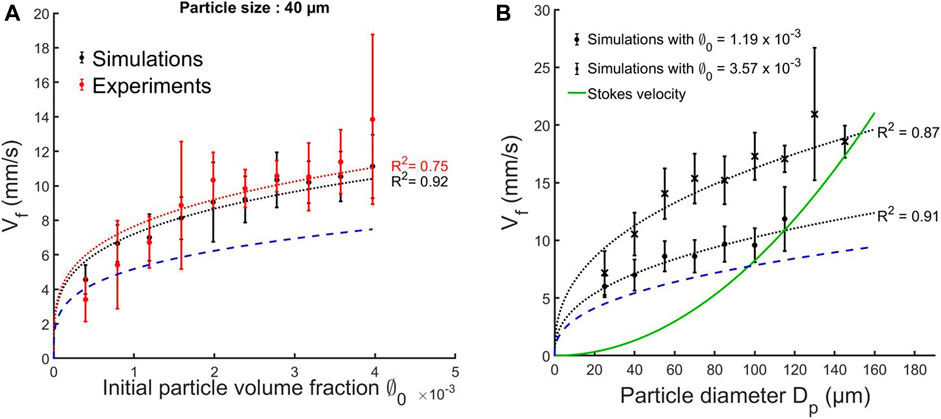
FIGURE 11. (A) Average finger speed (Vf) as a function of the initial volume fraction (
By analogy with thermal convection, it has previously been assumed that
Since gravitational instabilities cause particles to sediment faster than their settling velocity, it is of interest to explore the transition from collective to individual settling, since this has implications for which grain sizes may prematurely sediment from a volcanic cloud (Scollo et al., 2017). Figure 11B shows the effect of particle size on the finger velocity as measured from the model, for two different initial volume fractions, in the experiments configuration (i.e., in the tank filled with water). We clearly observe two regimes:
• For particle sizes less than or equal to 115 µm (for
• For greater particle sizes, no fingers are observed to form.
From our simulations, we constrain the transition between the two regimes to occur at a critical particle diameter around 115 and 145 µm respectively for
Given the excellent agreement between the proposed model and both LSA analysis and analogue experiments described above, we take advantage of having 3D data from the numerical simulations in order to extract other parameters which are difficult to obtain otherwise (Fries et al., 2021). Three interesting parameters are the particle mass flux across a plane, the particle concentration in the lower layer and the amount of particles accumulated at the bottom of the tank, which can be related to the accumulation rate. The latter is especially interesting as, when the model is applied to volcanic clouds, it could eventually be compared with field data (Bonadonna et al., 2011).
We calculate the mass flux across a horizontal plane (actually a thin box of thickness
where
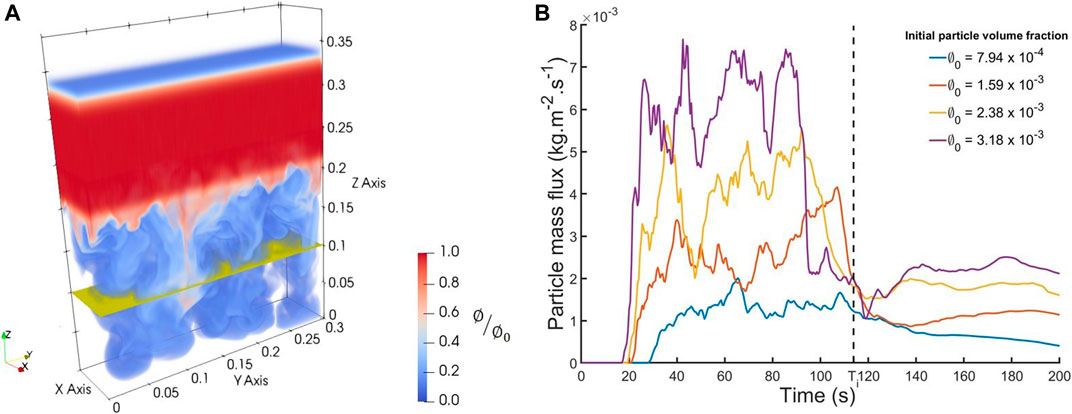
FIGURE 12. (A) Horizontal planar surface (yellow slice) located 0.15 m below the barrier, across which the particle mass flux is computed in the simulation domain. (B) Temporal evolution for the particle mass flux crossing the plane. Black dashed line: theoretical time for the particles to reach the plane at their individual Stokes velocity.
Another way to highlight the enhancement of the sedimentation rate by collective settling is to study the spatial distribution of particles beneath the interface. Assuming a quiescent upper layer and a convective lower layer, akin to our simulations, Hoyal et al. (1999) derived Eq. 4 for the evolution of the particle concentration in the lower layer. The derivation of this formulation assumes that
where
An interesting result coming out of the previous analytical study is the mass of particles accumulating at the bottom of the tank and the associated accumulation rate. We can derive an analytical prediction for the mass of particles
where
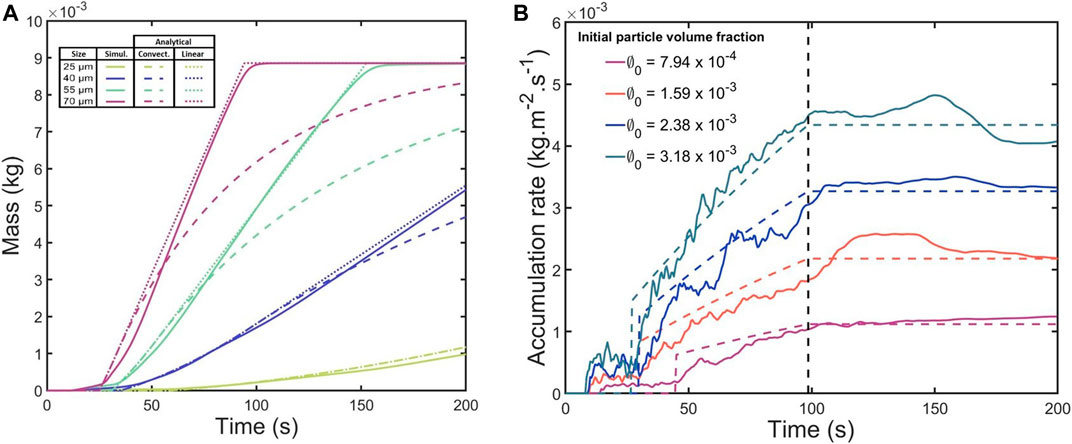
FIGURE 13. (A) Temporal evolution of the mass of particles accumulating at the bottom of the tank for several particle sizes. The dashed and dotted lines represent the extended analytical model of (Hoyal et al., 1999). Particle volume fraction
We observe, for each initial particle volume fraction, an initial increase of the accumulation rate with time which reflects the enhancement of the sedimentation process due to convection. Interestingly, the accumulation rate then reaches a plateau at around
Finally, using the determined
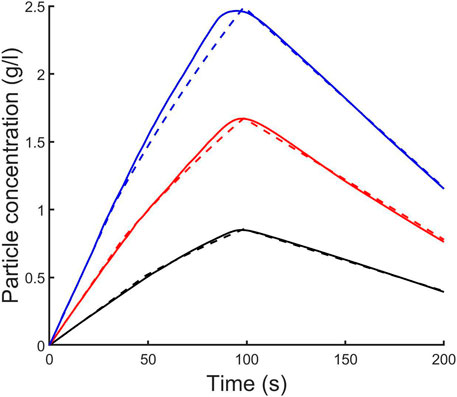
FIGURE 14. Evolution of the average particle volume fraction in the lower layer for particle of size 40 µm. Black:
Our numerical model has been validated by comparing various outputs with results from linear stability analysis, lab experiments (Fries et al., 2021) and theoretical predictions from previous studies (Hoyal et al., 1999; Carazzo and Jellinek, 2012). Even though these comparisons are good (Figures 9–14), the results provided by the model inherits the caveats of the experiments. Indeed, the static and confined configuration, as well as the fact that we performed the simulations in water, mean that we cannot fully extend the results to the volcanic case yet. Thus, further investigations are necessary to better simulate the volcanic environment (e.g., in air, with wind, etc.). Additionally, it is necessary to consider the limits of validity of the different assumptions. In our study, particles are small enough that they have no inertia and thus the fluid-particle interaction force is governed by the buoyant force term in the fluid momentum equation. However, as soon as the particle size increases, we need to consider some other dynamics. Indeed, a rigid particle moving in a fluid produces locally a disturbance flow which generates other contributions to the fluid-particle force terms. The assumption that particles settle at their Stokes velocity will then no longer be valid as the created local flow affects
Whilst the condition on the particle coupling is given by the Stokes number (
Another related caveat concerns the numerical diffusion underlying the use of an Eulerian approach to describe the transport of particles. Compared to classical first order finite difference methods, the use of the third order WENO procedure has drastically reduced the numerical diffusion. It is also possible to further reduce the induced numerical diffusion by increasing the order of the WENO scheme (i.e. increase also the computational cost). However, for problems purely related to advection, where the presence of any diffusion is critical, another strategy, such as two-phase models (using a Lagrangian approach where individual particles are explicitly modelled), has to be considered.
We have compared the simulated vertical velocity of fingers with experimental observations (Fries et al., 2021) and a theoretical prediction (Eq. 1) from (Hoyal et al., 1999; Carazzo and Jellinek, 2012) (Figure 11). This expression depends on a critical Grashof number, which by analogy with thermal convection (Turner, 1973) has previously been assumed to be 103 (Hoyal et al., 1999). This value effectively corresponds to a dimensionless critical PBL thickness at which point the PBL can detach and form fingers. However, both the model results and experimental observations summarised in Figure 11 suggest that
The predicted dependence of the finger velocity on the particle diameter by Eq. 1 shows a very good agreement with our simulated results, as confirmed by a power-law fitting between
The main caveats for this formulation are that it strongly depends on having a correct scaling for
We have proposed a modified analytical formulation for the particle concentration in the lower layer
The analytical predictions for
Another interesting result concerns the accumulation rate of particles at the base of the domain in the presence of fingers. Figure 13B shows the accumulation rate increases with time for
We have presented an innovative hybrid Lattice Boltzmann-Finite Difference 3D model in order to simulate settling-driven gravitational instabilities at the base of volcanic ash clouds. Such instabilities occur when particles settle through a density interface at the base of a suspension, leading to the formation of an unstable particle boundary layer (Hoyal et al., 1999; Carazzo and Jellinek, 2012; Manzella et al., 2015), and also occur in other natural settings, such as river plumes (Davarpanah Jazi and Wells, 2016). Our numerical model makes use of a low-diffusive WENO procedure to solve the advection-diffusion-settling equation for the particle volume fraction. The use of such a routine allows us to minimise errors associated with numerical diffusion and has the advantage of being applied to simple uniform meshes, which makes the coupling with the LBM easier. This innovative use of the WENO scheme, therefore, represents an effective tool for the solving of advection-dominated problems. Our implementation of the third order WENO finite difference scheme will be integrated in a future release of the open-source Palabos code. Our model has been successfully validated by comparing the results with 1) predictions from linear stability analysis where we show that the model is able to simulate settling-driven gravitational instabilities from the initial disturbance through the linearly-unstable regime, 2) analogue experiments (Fries et al., 2021) and 3) theoretical models (Hoyal et al., 1999; Carazzo and Jellinek, 2012) in order to reproduce the non-linear regime which describes the downward propagation of fingers. We also confirmed the premature sedimentation process through collective settling compared to individual settling.
Our model provides new insights into:
• The value of the critical Grashof number. From measurements of the vertical finger speed, we have found
• The presence of a particle size threshold for the finger formation. Using our results, we have proposed an analytical formulation for this threshold depending on the density of particles, the viscosity of the medium and also the bulk density difference between the two fluid layers.
• The signature of settling-driven gravitational instabilities (i.e., accumulation rate). We show that the accumulation rate of particles at the tank base initially increases with time before reaching a plateau. This contrasts with the constant accumulation rate associated with individual particle settling. This suggests that accumulation rate data could be used during tephra fallout to distinguish between sedimentation through settling-driven gravitational instabilities and individual-particle sedimentation.
We have also demonstrated how our numerical model can be used to expand the initial conditions and configuration settings that can be explored through experimental investigations. The results presented so far in an aqueous media permitted model validation but have also opened fundamental questions that will be addressed in future works involving configurations more similar to the natural system. Indeed, thanks to the strengths of the LBM, the model can easily be applied to more complex systems and provides a robust tool for the transition from the laboratory studies to volcanic systems, as well as other environmental flows.
The raw data supporting the conclusions of this article will be made available by the authors, without undue reservation.
JL integrated the WENO procedure in the Palabos framework, conducted the simulations and data analysis under the supervision of PJ, JLä, CB, and BC. JL drafted the manuscript. JLä and BC were involved in the development of the Palabos code. All authors have contributed to data interpretation as well as the editing and finalising of the paper.
The study has been funded by the Swiss National Science Foundation #200021_169463.
The authors declare that the research was conducted in the absence of any commercial or financial relationships that could be construed as a potential conflict of interest.
All claims expressed in this article are solely those of the authors and do not necessarily represent those of their affiliated organizations, or those of the publisher, the editors and the reviewers. Any product that may be evaluated in this article, or claim that may be made by its manufacturer, is not guaranteed or endorsed by the publisher.
All the simulations presented in this paper have been performed using the High Performance Computing (HPC) facilities Baobab and Yggdrasil of the University of Geneva. We would like to thank Amanda B. Clarke and Jeremy C. Phillips for constructive discussions. The authors are grateful to SS, TM, BA and the Editor for their constructive reviews. A preprint of this work has been submitted on the arXiv server in the Fluid Dynamics category on the June 14, 2021: arXiv:2106.07694 (Lemus et al., 2021).
The Supplementary Material for this article can be found online at: https://www.frontiersin.org/articles/10.3389/feart.2021.713175/full#supplementary-material.
Alsinan, A., Meiburg, E., and Garaud, P. (2017). A Settling-Driven Instability in Two-Component, Stably Stratified Fluids. J. Fluid Mech. 816, 243–267. doi:10.1017/jfm.2017.94
Bagnato, E., Aiuppa, A., Bertagnini, A., Bonadonna, C., Cioni, R., Pistolesi, M., et al. (2013). Scavenging of sulphur, Halogens and Trace Metals by Volcanic Ash: The 2010 Eyjafjallajökull Eruption. Geochimica et Cosmochimica Acta 103, 138–160. doi:10.1016/j.gca.2012.10.048
Baltensperger, R., and Berrut, J.-P. (2001). The Linear Rational Collocation Method. J. Comput. Appl. Math. 134, 243–258. doi:10.1016/s0377-0427(00)00552-5
Berrut, J.-P., and Mittelmann, H. D. (2004). Adaptive point Shifts in Rational Approximation with Optimized Denominator. J. Comput. Appl. Math. 164-165, 81–92. doi:10.1016/S0377-0427(03)00485-0
Bhatnagar, P. L., Gross, E. P., and Krook, M. (1954). A Model for Collision Processes in Gases. Phys. Rev. 94, 515–525. doi:10.1103/physrev.94.511
Blong, R. (2000). “Volcanic Hazards and Risk Management,” in Encyclopedia of Volcanoes (Cambridge: Academic Press), 1215–1227.
Bonadonna, C., Biass, S., Menoni, S., and Gregg, C. E. (2021). Assessment of Risk Associated with Tephra-Related Hazards. Forecasting and Planning for Volcanic Hazards, Risks, and Disasters 2, 329–378. doi:10.1016/b978-0-12-818082-2.00008-1
Bonadonna, C., Folch, A., Loughlin, S., and Puempel, H. (2012). Future Developments in Modelling and Monitoring of Volcanic Ash Clouds: Outcomes from the First IAVCEI-WMO Workshop on Ash Dispersal Forecast and Civil Aviation. Bull. Volcanol. 74, 1–10. doi:10.1007/s00445-011-0508-6
Bonadonna, C., Genco, R., Gouhier, M., Pistolesi, M., Cioni, R., Alfano, F., et al. (2011). Tephra Sedimentation during the 2010 Eyjafjallajökull Eruption (Iceland) from deposit, Radar, and Satellite Observations. J. Geophys. Res. 116. doi:10.1029/2011JB008462
Brown, R. J., Bonadonna, C., and Durant, A. J. (2012). A Review of Volcanic Ash Aggregation. Phys. Chem. Earth 45–46, 67–78. doi:10.1016/j.pce.2011.11.001
Burgisser, A., Bergantz, G. W., and Breidenthal, R. E. R. (2005). Addressing Complexity in Laboratory Experiments: The Scaling of Dilute Multiphase Flows in Magmatic Systems. J. Volcanology Geothermal Res. 141, 245–265. doi:10.1016/j.jvolgeores.2004.11.001
Burns, P., and Meiburg, E. (2012). Sediment-laden Fresh Water above Salt Water: Linear Stability Analysis. J. Fluid Mech. 691, 279–314. doi:10.1017/jfm.2011.474
Burns, P., and Meiburg, E. (2014). Sediment-laden Fresh Water above Salt Water: Nonlinear Simulations. J. Fluid Mech. 762, 156–195. doi:10.1017/jfm.2014.645
Carazzo, G., and Jellinek, A. M. (2012). A New View of the Dynamics, Stability and Longevity of Volcanic Clouds. Earth Planet. Sci. Lett. 325-326, 39–51. doi:10.1016/j.epsl.2012.01.025
Cardoso, S. S. S., and Zarrebini, M. (2001). Convection Driven by Particle Settling Surrounding a Turbulent Plume. Chem. Eng. Sci. 56, 3365–3375. doi:10.1016/S0009-2509(01)00028-8
Carey, S. (1997). Influence of Convective Sedimentation on the Formation of Widespread Tephra Fall Layers in the Deep Sea. Geol 25, 839–842. doi:10.1130/0091-7613(1997)025<0839:iocsot>2.3.co;2
Cartwright, J. H. E., Feudel, U., Károlyi, G., De Moura, A., Piro, O., and Tél, T. (2010). Dynamics of Finite-Size Particles in Chaotic Fluid Flows. Nonlinear Dynamics and Chaos: Advances and Perspectives 51(1), 87. doi:10.1007/978-3-642-04629-2_4
Chandrasekhar, S. (1961). Hydrodynamic and Hydromagnetic Stability. Oxford: Oxford University Press.
Chou, Y.-J., and Shao, Y.-C. (2016). Numerical Study of Particle-Induced Rayleigh-Taylor Instability: Effects of Particle Settling and Entrainment. Phys. Fluids 28, 043302. doi:10.1063/1.4945652
Costa, A., Folch, A., and Macedonio, G. (2010). A Model for Wet Aggregation of Ash Particles in Volcanic Plumes and Clouds: 1. Theoretical Formulation. J. Geophys. Res. 115, 1–14. doi:10.1029/2009JB007175
Crimaldi, J. P. (2008). Planar Laser Induced Fluorescence in Aqueous Flows. Exp. Fluids 44, 851–863. doi:10.1007/s00348-008-0496-2
Davarpanah Jazi, S., and Wells, M. G. (2016). Enhanced Sedimentation beneath Particle-Laden Flows in Lakes and the Ocean Due to Double-Diffusive Convection. Geophys. Res. Lett. 43, 10,883–10,890. doi:10.1002/2016GL069547
Durant, A. J. (2015). RESEARCH FOCUS: Toward a Realistic Formulation of fine-ash Lifetime in Volcanic Clouds. Geology 43, 271–272. doi:10.1130/focus032015.1
Folch, A. (2012). A Review of Tephra Transport and Dispersal Models: Evolution, Current Status, and Future Perspectives. J. Volcanology Geothermal Res. 235-236, 96–115. doi:10.1016/j.jvolgeores.2012.05.020
Folch, A., Mingari, L., Gutierrez, N., Hanzich, M., Macedonio, G., and Costa, A. (2020). FALL3D-8.0: A Computational Model for Atmospheric Transport and Deposition of Particles, Aerosols and Radionuclides - Part 1: Model Physics and Numerics. Geosci. Model. Dev. 13, 1431–1458. doi:10.5194/gmd-13-1431-2020
Fries, A., Lemus, J., Jarvis, P. A., Clarke, A. B., Phillips, J. C., Manzella, I., et al. (2021). The Influence of Particle Concentration on the Formation of Settling-Driven Gravitational Instabilities at the Base of Volcanic Clouds. Front. Earth Sci. 9. doi:10.3389/feart.2021.640090
Godunov (1959). A Difference Scheme for Numerical Solution of Discontinuous Solution of Hydrodynamic Equations. Math. Sb. 47, 271–306.
Gouhier, M., Eychenne, J., Azzaoui, N., Guillin, A., Deslandes, M., Poret, M., et al. (2019). Low Efficiency of Large Volcanic Eruptions in Transporting Very fine Ash into the Atmosphere. Sci. Rep. 9, 1–12. doi:10.1038/s41598-019-42489-z
Gudmundsson, G. (2011). Respiratory Health Effects of Volcanic Ash with Special Reference to Iceland. A Review. Clin. Respir. J. 5, 2–9. doi:10.1111/j.1752-699X.2010.00231.x
Guffanti, M., Mayberry, G. C., Casadevall, T. J., and Wunderman, R. (2008). Volcanic Hazards to Airports. Nat. Hazards 51, 287–302. doi:10.1007/s11069-008-9254-2
Guo, Z., Zheng, C., and Shi, B. (2002). Discrete Lattice Effects on the Forcing Term in the Lattice Boltzmann Method. Phys. Rev. E 65, 1–6. doi:10.1103/PhysRevE.65.046308
Harada, S., Kondo, M., Watanabe, K., Shiotani, T., and Sato, K. (2013). Collective Settling of fine Particles in a Narrow Channel with Arbitrary Cross-Section. Chem. Eng. Sci. 93, 307–312. doi:10.1016/j.ces.2013.01.054
He, X., and Luo, L.-S. (1997). Theory of the Lattice Boltzmann Method: From the Boltzmann Equation to the Lattice Boltzmann Equation. Phys. Rev. E 56, 6811–6817. doi:10.1103/PhysRevE.56.6811
Hosseini, S. A., Darabiha, N., Thévenin, D., and Eshghinejadfard, A. (2017). Stability Limits of the Single Relaxation-Time Advection-Diffusion Lattice Boltzmann Scheme. Int. J. Mod. Phys. C 28, 1750141. doi:10.1142/S0129183117501418
Hoyal, D. C. J. D., Bursik, M. I., and Atkinson, J. F. (1999). Settling-driven Convection: A Mechanism of Sedimentation from Stratified Fluids. J. Geophys. Res. 104, 7953–7966. doi:10.1029/1998jc900065
Jacobs, C. T., Collins, G. S., Piggott, M. D., Kramer, S. C., and Wilson, C. R. G. (2013). Multiphase Flow Modelling of Volcanic Ash Particle Settling in Water Using Adaptive Unstructured Meshes. Geophys. J. Int. 192, 647–665. doi:10.1093/gji/ggs059
Jenkins, S. F., Wilson, T. M., Magill, C., Miller, V., Stewart, C., Blong, R., et al. (2015). Volcanic Ash Fall hazard and Risk. Global Volcanic Hazards and Risk, 173–222. doi:10.1017/CBO9781316276273.005
Jiang, G.-S., and Shu, C.-W. (1996). Efficient Implementation of Weighted ENO Schemes. J. Comput. Phys. 126, 202–228. doi:10.1006/jcph.1996.0130
Jones, A., Thomson, D., Hort, M., and Devenish, B. (2007). The U.K. Met Office's Next-Generation Atmospheric Dispersion Model, NAME III. Air Pollut. Model. Its Appl. XVII 1, 580–589. doi:10.1007/978-0-387-68854-1_62
Keck, J.-B., Cottet, G.-H., Meiburg, E., Mortazavi, I., and Picard, C. (2021). Double-diffusive Sedimentation at High Schmidt Numbers: Semi-lagrangian Simulations. Phys. Rev. Fluids 6, 1–10. doi:10.1103/PhysRevFluids.6.L022301
Koochesfahani, M. M. (1984). Experiments on Turbulent Mixing and Chemical Reactions in a Liquid Mixing Layer. Journal of Fluid Mechanics. doi:10.7907/Y7BR-C556
Kruger, T., Kusumaatmaja, H., Kuzmin, A., Shardt, O., Goncalo, S., and Viggen, E. M. (2017). The Lattice Boltzmann Method. Principles and Practice 1. doi:10.1191/0265532206lt326oa
Laibe, G., and Price, D. J. (2014). Dusty Gas with One Fluid. Mon. Not. R. Astron. Soc. 440, 2136–2146. doi:10.1093/mnras/stu355
Latt, J., Malaspinas, O., Kontaxakis, D., Parmigiani, A., Lagrava, D., Brogi, F., et al. (2021). Palabos: Parallel Lattice Boltzmann Solver. Comput. Math. Appl. 81, 334–350. doi:10.1016/j.camwa.2020.03.022
Leclaire, S., Parmigiani, A., Malaspinas, O., Chopard, B., and Latt, J. (2017). Generalized Three-Dimensional Lattice Boltzmann Color-Gradient Method for Immiscible Two-phase Pore-Scale Imbibition and Drainage in Porous media. Phys. Rev. E 95, 33306. doi:10.1103/PhysRevE.95.033306
Lemus, J., Fries, A., Jarvis, P. A., Bonadonna, C., Chopard, B., and Latt, J. (2021). Modelling Settling-Driven Gravitational Instabilities at the Base of Volcanic Clouds Using the Lattice Boltzmann Method. Available at: https://arxiv.org/abs/2106.07694.
Lewis, D. J. (1950). The Instability of Liquid Surfaces when Accelerated in a Direction Perpendicular to Their Planes. II. Proc. R. Soc. Lond. A. 202, 81–96. doi:10.1098/rspa.1950.0086
Liu, X.-D., Osher, S., and Chan, T. (1994). Weighted Essentially Non-oscillatory Schemes. J. Comput. Phys. 115(1), 1–32. doi:10.1006/jcph.1994.1187
Manville, V., and Wilson, C. J. N. (2004). Vertical Density Currents: A Review of Their Potential Role in the Deposition and Interpretation of Deep-Sea Ash Layers. J. Geol. Soc. 161, 947–958. doi:10.1144/0016-764903-067
Manzella, I., Bonadonna, C., Phillips, J. C., and Monnard, H. (2015). The Role of Gravitational Instabilities in Deposition of Volcanic Ash. Geology 43, 211–214. doi:10.1130/G36252.1
Maters, E. C., Cimarelli, C., Casas, A. S., Dingwell, D. B., and Murray, B. J. (2020). Volcanic Ash Ice-Nucleating Activity Can Be Enhanced or Depressed by Ash-Gas Interaction in the Eruption Plume. Earth Planet. Sci. Lett. 551, 116587. doi:10.1016/j.epsl.2020.116587
Maxey, M. R., and Riley, J. J. (1983). Equation of Motion for a Small Rigid Sphere in a Nonuniform Flow. Phys. Fluids 26, 883–889. doi:10.1063/1.864230
Niemeier, U., Timmreck, C., Graf, H.-F., Kinne, S., Rast, S., Self, S., et al. (2009). Initial Fate of fine Ash and Sulfur from Large Volcanic Eruptions. Atmos. Chem. Phys. 9, 9043–9057. doi:10.5194/acp-9-9043-2009
Noriega, H., Reggio, M., and Vasseur, P. (2013). Natural Convection of Nanofluids in a Square Cavity Heated from below. Comput. Therm. Sci. Int. J. 5. doi:10.1615/computthermalscien.2013006652
Parmigiani, A., Huber, C., Chopard, B., Latt, J., and Bachmann, O. (2009). Application of the Multi Distribution Function Lattice Boltzmann Approach to thermal Flows. Eur. Phys. J. Spec. Top. 171, 37–43. doi:10.1140/epjst/e2009-01009-7
Patočka, V., Calzavarini, E., and Tosi, N. (2020). Settling of Inertial Particles in Turbulent Rayleigh-Bénard Convection. Phys. Rev. Fluids 5, 1–36. doi:10.1103/PhysRevFluids.5.114304
Prata, A. T., Mingari, L., Folch, A., Macedonio, G., and Costa, A. (2021). FALL3D-8.0: A Computational Model for Atmospheric Transport and Deposition of Particles, Aerosols and Radionuclides - Part 2: Model Validation. Geosci. Model. Dev. 14, 409–436. doi:10.5194/gmd-14-409-2021
Prata, F., and Rose, B. (2015). Volcanic Ash Hazards to Aviation, ed. H. B. T.-T. E. of V. (Second E. Sigurdsson (Amsterdam: Academic Press), 911–934. doi:10.1016/B978-0-12-385938-9.00052-3
Roche, O., and Carazzo, G. (2019). The Contribution of Experimental Volcanology to the Study of the Physics of Eruptive Processes, and Related Scaling Issues: A Review. J. Volcanology Geothermal Res. 384, 103–150. doi:10.1016/j.jvolgeores.2019.07.011
Scollo, S., Bonadonna, C., and Manzella, I. (2017). Settling-driven Gravitational Instabilities Associated with Volcanic Clouds: New Insights from Experimental Investigations. Bull. Volcanol. 79, 1–14. doi:10.1007/s00445-017-1124-x
Scollo, S., Folch, A., Coltelli, M., and Realmuto, V. J. (2010). Three-dimensional Volcanic Aerosol Dispersal: A Comparison between Multiangle Imaging Spectroradiometer (MISR) Data and Numerical Simulations. J. Geophys. Res. 115, 1–14. doi:10.1029/2009JD013162
Scollo, S., Tarantola, S., Bonadonna, C., Coltelli, M., and Saltelli, A. (2008). Sensitivity Analysis and Uncertainty Estimation for Tephra Dispersal Models. J. Geophys. Res. Solid Earth 113, 1–17. doi:10.1029/2006jb004864
Sharp, D. H. (1984). An Overview of Rayleigh-Taylor Instability. Physica D: Nonlinear Phenomena 12, 3–18. doi:10.1016/0167-2789(84)90510-4
Spence, R. J. S., Kelman, I., Baxter, P. J., Zuccaro, G., and Petrazzuoli, S. (2005). Residential Building and Occupant Vulnerability to Tephra Fall. Nat. Hazards Earth Syst. Sci. 5, 477–494. doi:10.5194/nhess-5-477-2005
Stenchikov, G., Ukhov, A., Osipov, S., Ahmadov, R., Grell, G., Cady‐Pereira, K., et al. (2021). How Does a Pinatubo‐Size Volcanic Cloud Reach the Middle Stratosphere. Geophys. Res. Atmos. 126. doi:10.1029/2020JD033829
Stokes, G. G. (1851). On the Theories of the Internal Friction of Fluids in Motion, and of the Equilibrium and Motion of Elastic Solids. Math. Phys. Pap. 19, 75–129. doi:10.1017/CBO9780511702242.005
Succi, S., Sbragaglia, M., and Ubertini, S. (2010). Lattice Boltzmann Method. Scholarpedia 5, 9507. doi:10.4249/scholarpedia.9507
Turner, J. S. (1973, Buoyancy Effects in Fluids. Cambridge: Cambridge University Press. doi:10.1017/CBO9780511608827
Völtz, C., Pesch, W., and Rehberg, I. (2001). Rayleigh-Taylor Instability in a Sedimenting Suspension. Phys. Rev. E 65, 011404. doi:10.1103/PhysRevE.65.011404
Watt, S. F. L., Gilbert, J. S., Folch, A., Phillips, J. C., and Cai, X. M. (2015). An Example of Enhanced Tephra Deposition Driven by Topographically Induced Atmospheric Turbulence. Bull. Volcanol. 77, 35. doi:10.1007/s00445-015-0927-x
Wilson, T. M., Cole, J. W., Stewart, C., Cronin, S. J., and Johnston, D. M. (2011). Ash Storms: Impacts of Wind-Remobilised Volcanic Ash on Rural Communities and Agriculture Following the 1991 Hudson Eruption, Southern Patagonia, Chile. Bull. Volcanol. 73, 223–239. doi:10.1007/s00445-010-0396-1
Yamamoto, Y., Hisataka, F., and Harada, S. (2015). Numerical Simulation of Concentration Interface in Stratified Suspension: Continuum-Particle Transition. Int. J. Multiphase Flow 73, 71–79. doi:10.1016/j.ijmultiphaseflow.2015.03.007
Yu, X., Hsu, T.-J., and Balachandar, S. (2014). Convective Instability in Sedimentation: 3-D Numerical Study. J. Geophys. Res. Ocean., 3868–3882. doi:10.1002/2014jc010123
Yu, X., Hsu, T.-J., and Balachandar, S. (2013). Convective Instability in Sedimentation: Linear Stability Analysis. J. Geophys. Res. Oceans 118, 256–272. doi:10.1029/2012JC008255
Keywords: volcanic ash, ash sedimentation, tephra, weighted essentially non-oscillatory, finite-difference, high performance computing
Citation: Lemus J, Fries A, Jarvis PA, Bonadonna C, Chopard B and Lätt J (2021) Modelling Settling-Driven Gravitational Instabilities at the Base of Volcanic Clouds Using the Lattice Boltzmann Method. Front. Earth Sci. 9:713175. doi: 10.3389/feart.2021.713175
Received: 21 May 2021; Accepted: 07 October 2021;
Published: 21 October 2021.
Edited by:
Sara Barsotti, Icelandic Meteorological Office, IcelandReviewed by:
Stephen Solovitz, Washington State University Vancouver, United StatesCopyright © 2021 Lemus, Fries, Jarvis, Bonadonna, Chopard and Lätt. This is an open-access article distributed under the terms of the Creative Commons Attribution License (CC BY). The use, distribution or reproduction in other forums is permitted, provided the original author(s) and the copyright owner(s) are credited and that the original publication in this journal is cited, in accordance with accepted academic practice. No use, distribution or reproduction is permitted which does not comply with these terms.
*Correspondence: Jonathan Lemus, am9uYXRoYW4ubGVtdXNAdW5pZ2UuY2g=
Disclaimer: All claims expressed in this article are solely those of the authors and do not necessarily represent those of their affiliated organizations, or those of the publisher, the editors and the reviewers. Any product that may be evaluated in this article or claim that may be made by its manufacturer is not guaranteed or endorsed by the publisher.
Research integrity at Frontiers

Learn more about the work of our research integrity team to safeguard the quality of each article we publish.